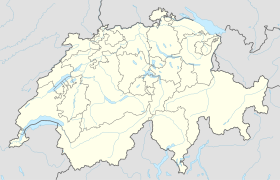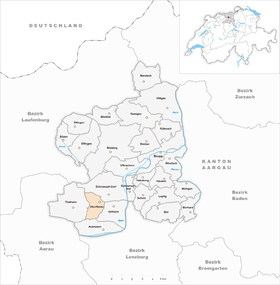Upper flax
| Upper flax | ||
|---|---|---|
| State : |
|
|
| Canton : |
|
|
| District : | Brugg | |
| Residential municipality : | Schinznach | |
| Postal code : | 5108 | |
| former BFS no. : | 4109 | |
| Coordinates : | 652 189 / 254679 | |
| Height : | 398 m above sea level M. | |
| Residents: | 497 (December 31, 2013) | |
|
Proportion of foreigners : (residents without citizenship ) |
k, A,% (December 31, 2019) | |
|
Upper flax |
||
| map | ||
|
|
||
Oberflachs ( Swiss German : ˈɔbəɾˌflɑgs ) is a village in the Swiss canton of Aargau . It is located about six kilometers southwest of the district capital in the Schenkenbergertal . Until the end of 2013 it was an independent community in the Brugg district and then merged with the neighboring Schinznach village on January 1, 2014 to form the new community of Schinznach .
geography
The village is located in the Schenkenbergertal , which extends in an east-west direction from the Aare near Schinznach-Dorf to Staffelegg . This valley is bordered by two steep mountain ranges of the Folded Jura . In the south, the municipality extends to the ridge of the Gislifluh at an altitude of 770 meters, in the north to just below the summit of the Grund (up to a height of 665 meters). There are vineyards on the southern slope of the Grund and at Kasteln Castle .
The area of the former municipality was 338 hectares . Its highest point was at 770 meters on the Gisifluhgrat, the lowest at 395 meters on the former eastern municipality border. Neighboring communities were Schinznach-Dorf in the north, Veltheim in the east, Auenstein in the south and Thalheim in the west.
history
Various finds of bricks and coins suggest a settlement by the Romans . Obernflacht was first mentioned in a document in 1301. The place name comes from the Old High German (ze dero) obarun flahidu and means "at the upper flat spot". The village probably came into being a century earlier, because in 1238 the inns of Kasteln, vassals of the Kyburgs, were mentioned . Ruchenstein Castle was built on the same hill as Kasteln Castle in 1262 . In 1273 rulership passed to the Habsburgs after the Kyburgs had died out. In 1311 the Lords of Mülinen acquired the village and the two castles that together made up the small lordship of Kasteln.
When the city of Bern conquered the Schenkenbergertal in 1460 , the Lords of Mülinen could continue to exercise their rights, such as the lower jurisdiction . In 1528 the Bernese introduced the Reformation . Colonel Johann Ludwig von Erlach acquired the rule of Kasteln in 1631 and made it his private property. With the remains of Ruchenstein Castle, which burned down in 1642, he had Kasteln Castle expanded into a palace. In 1732 the city of Bern acquired the rule of Kasteln for 90,000 thalers , and the castle became the seat of the smallest bailiwick in the Bernese Aargau .
In March 1798 the French marched into Switzerland, ousted the «Gracious Lords» of Bern and proclaimed the Helvetic Republic . Since then, Oberflachs has belonged to the canton of Aargau. A major fire in 1817 destroyed around a third of the village. In addition to grain cultivation, viticulture was an important branch of business from the 17th century. This fell sharply from 1850 onwards due to vine diseases and the phylloxera epidemic . As a result, many residents became impoverished and were forced to emigrate overseas. Until the middle of the 20th century, the population continued to live almost exclusively from agriculture
On April 5, 2009, the voters approved a merger with Schinznach-Bad , Schinznach-Dorf , Veltheim and Villnachern to form the new municipality of Schenkenberg . However, it did not materialize because Veltheim refused it. The subsequently initiated merger project without Veltheim failed on October 25, 2009 due to Villnachern's negative attitude. Then only Oberflachs and Schinznach-Dorf tried to merge. The corresponding resolution was confirmed in a mandatory referendum on June 18, 2012 and the merger finally took place on January 1, 2014.
Attractions
Kasteln Castle stands on a small hill about half a kilometer west of the village . From 1855 an institution for "orphaned and neglected pupils" existed in the castle, which was given the status of a foundation in 1923 and was converted into a school home for normally gifted, behavioral pupils in 1955. The building burned down almost completely in 1907 and was rebuilt the following year.
coat of arms
The blazon of today's coat of arms and earlier municipal coat of arms reads: "In white three crossed blue flax flowers with green leafy stems." This so-called talking coat of arms is supposed to symbolize the place name, but the image of flax goes back to a misinterpretation of the name. As early as 1811, an upright bundle of flax was depicted on the municipal seal, and finally three crossed ones in 1872. In 1965 the coat of arms was revised and simplified.
population
The population developed as follows:
| year | 1764 | 1850 | 1900 | 1930 | 1950 | 1960 | 1970 | 1980 | 1990 | 2000 | 2010 |
| Residents | 215 | 512 | 428 | 369 | 364 | 405 | 433 | 471 | 466 | 468 | 482 |
On December 31, 2013, 497 people lived in Oberflachs. In the 2000 census, 72.6% described themselves as Reformed and 16.2% as Roman Catholic ; 11.2% were non-denominational or of other faiths. 98.3% named German as their main language.
traffic
Oberflachs is on Kantonsstrasse 474, which leads from Schinznach-Bad through the Schenkenbergertal to the Staffelegg -Passhöhe. A side street leads to Veltheim . The village is connected to the public transport network by a post bus line that runs from Brugg train station to Thalheim . On weekends there is a night bus from Brugg via Schinznach-Bad and Oberflachs to Thalheim.
literature
- Felix Müller: Oberflachs. In: Historical Lexicon of Switzerland .
- Michael Stettler , Emil Maurer : The art monuments of the canton of Aargau . In: Society for Swiss Art History (Ed.): Art Monuments of Switzerland . Volume II: The districts of Lenzburg and Brugg. Birkhäuser Verlag, Basel 1953, DNB 750561750 .
Web links
Individual evidence
- ↑ Cantonal population statistics 2019. Department of Finance and Resources, Statistics Aargau, March 30, 2020, accessed on April 2, 2019 .
- ↑ a b Beat Zehnder: The community names of the canton of Aargau . In: Historical Society of the Canton of Aargau (Ed.): Argovia . tape 100 . Verlag Sauerländer, Aarau 1991, ISBN 3-7941-3122-3 , p. 312-313 .
- ^ National map of Switzerland, sheets 1069 and 1089, Swisstopo.
- ↑ Fusion of five failed. Aargauer Zeitung , April 5, 2009, accessed on January 28, 2010 .
- ↑ Villnachern clearly decides against «Schinznach». Aargauer Zeitung , October 25, 2009, accessed on August 10, 2010 .
- ↑ Oberflachs and Schinznach-Dorf are definitely merging. Aargauer Zeitung , June 18, 2012, accessed on June 12, 2019 .
- ^ Joseph Galliker, Marcel Giger: Municipal coat of arms of the Canton of Aargau . Lehrmittelverlag des Kantons Aargau, book 2004, ISBN 3-906738-07-8 , p. 233 .
- ↑ Population development in the municipalities of the Canton of Aargau since 1850. (Excel) In: Eidg. Volkszählung 2000. Statistics Aargau, 2001, archived from the original on October 8, 2018 ; accessed on June 12, 2019 .
- ↑ Swiss Federal Census 2000: Economic resident population by religious affiliation as well as by districts and municipalities. (Excel) Statistics Aargau, archived from the original on October 8, 2018 ; accessed on June 12, 2019 .
- ↑ Swiss Federal Census 2000: Economic resident population by main language as well as by districts and municipalities. (Excel) Statistics Aargau, archived from the original on August 10, 2018 ; accessed on June 12, 2019 .





